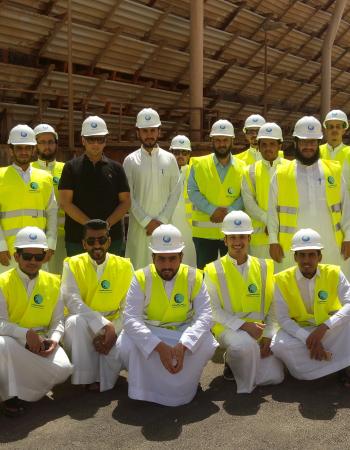GE 302
| GE 302 Industry and the Environment |
|
| Department of Civil Engineering King Saud University |
|
| Course Description: GE 302 Industry and the Environment (Required for a BScE degree) |
This course gives an introduction to the impact of engineering and industrial activities on the environment. The lectures cover: basics of ecosystems, environmental balance, types of pollution, and types, sources, and limits of pollutants; in addition to fundamentals of Environmental Impact Assessment (EIA). Pollution control technologies and examples of pollution from various engineering and industrial sectors are also covered. The course also includes a group term project. 2(2,0,0) |
| Prerequisite | None |
| Course Learning Objectives | Students completing this course successfully will be able to:
|
| Topics Covered |
|
| Class/ Tutorial Schedule | Classes are held once per week in 100-minute lecture session or over two-weekly 50-minute lecture sessions. |
| Computer Applications | Searching the internet for related topics is encouraged during the course and for facilitating the term project. |
| Project | A project is offered for the students in groups during the course, to improve their understanding of environmental engineering systems and fundamentals as well as relevant contemporary issues (i.e. recycling of materials, global warming, green technologies, sustainable development and public health). Such project includes collection of information and/or studying cases of pollution from an industry, to emphasize the linkage between real cases of pollution and control with the course content. A written report and oral presentation is required. |
| Contribution of Course to Meeting the Professional Component |
|
| Relationship of Course to Program Outcomes |
|
| Textbook(s) and Other Supporting Materials: |
|
| Prepared by | Dr. Abduaziz O. Al-Jasser |
| Date of Preparation | May, 2006 |
| Date of Update | June and Oct. 2009 (Dr. Hesham Fouli & Dr. Waleed Zahid) Feb. 2010 (Dr. Abduaziz O. Al-Jasser & Dr. Hesham Fouli) Sept. 2011 (Dr. Ibrahim Al-Sebaie, Dr. Saleh Al-Hassoun & Dr. Hesham Fouli) Jan. 2014 (Dr. Mohab Kamal) Sep. 2017 (Dr. Mohab Kamal) |
Grade Distribution
Mid-term Exam 1 20%
Mid-term Exam 2 20%
Project 10%
Final Exam 40%
Homework and Reports
Term project report on relevant contemporary issues or other suitable topics must be submitted and oral presentations delivered by students on the specified times. Late submission will be penalized. Submissions must be neat and clean on A4 paper format. The report must include: table of contents, page numbers, structured sections and well documented references. Report length is between 20 and 25 pages, aerial font with main text point size 12 and single-line spaced. Oral presentations will be within 15 minutes each and will be judged based on: content, clarity, time management, eye contact and attempt to use English language.
Notes for Excused Absences
According to the university regulations, student absence times should not exceed 25% of lecture times, to attend the final exam. Excused absence notes; e.g. medical, should be submitted to the instructor within one week following the absence.

